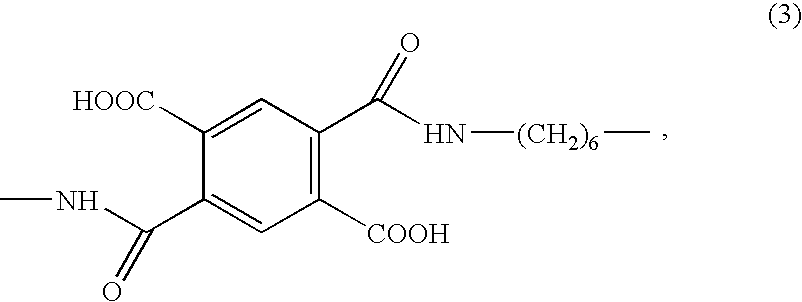Single-crystalline film and process for production thereof
a single-crystalline film and film technology, applied in the direction of polycrystalline material growth, instruments, transportation and packaging, etc., can solve the problems of difficult preparation of uniform films, failure to provide single-crystalline films, and difficult to obtain single-crystalline thin films
- Summary
- Abstract
- Description
- Claims
- Application Information
AI Technical Summary
Problems solved by technology
Method used
Image
Examples
example 1
[0047] A cell having a layer structure schematically illustrated in FIG. 1 was prepared.
[0048] Two glass sheets each having a thickness of 1.1 mm and an areal size of ca. 20 mm.times.20 mm were respectively coated with a 700 .ANG.-thick ITO transparent conductor film by sputtering and further with a 0.7 wt. % solution in NMP (N-methylpyrrolidone) of a polyamic acid ("LP-64", made by Toray K. K.) having a recurring unit of formula (3) below by spin coating at 2000 rpm for 20 sec: 2
[0049] followed by pre-drying at 80.degree. C. for 5 min. and baking at 200.degree. C. for 60 min. to form a 50 .ANG.-thick film of polyimide represented by formula (4) below: 3
[0050] The polyimide film on each glass substrate was subjected to four times of rubbing in one direction with a nylon-planted cloth at a roller feed speed of 10 mm / sec and a roller revolution speed of 1000 rpm.
[0051] The two substrates treated in the above-described manner were applied to each other with 2.4 .mu.m-dia. spacer beads ...
example 1a
[0054] In order to examine the crystalline order of the respective regions in the crystalline film obtained in Example 1, a cell for X-ray diffraction analysis was prepared in the same manner as in Example 1 except for using 80 .mu.m-thick glass substrates.
[0055] The cell was set in a rotary pair cathode-type X-ray diffraction apparatus ("RU-300", made by Rigaku Denki K. K.) having an organization as illustrated in FIG. 10 to obtain X-ray diffraction patterns for the single crystal region (s-crystal) and poly-crystal region (p-crystal) respectively in FIG. 6 by a transmission method under the following conditions:
[0056] X-ray source: CuKa, 40 kV, 200 mA
[0057] Measurement conditions:
[0058] Effective line focus width=0.05 mm S1=0.15 mm, S2=SS2 deg., S3=0.3 mm,
[0059] Ni filter
[0060] Focus-S1=95 mm, S1-Sample=90 mm,
[0061] Sample-S2=143 mm, S2-S3=42 mm
[0062] Incident angle (.alpha. deg.)=fixed
[0063] 2.theta.-scan 1 deg. / min., Interval=0.02 deg.
[0064] Angle resolution=ca. 3.5 rad (=ca. 0....
example 2
[0068] The cell prepared in Example 1 was again heated to a nematic phase temperature (130.degree. C.) and thereafter started to be cooled at a rate of 1.degree. C. / min. similarly as in Example 1. In this Example, however, the cell was not continually cooled to room temperature as in Example 1 but held for 30 min. at 118.degree. C. which was a crystal phase temperature lower than the SmC-Crystal transition temperature (=122.degree. C.) and thereafter cooled to room temperature. In the meantime, the alignment states were photographed through a polarizing microscope after holding for 1 min. and 10 min., respectively, at 118.degree. C. The thus-obtained photographs (each in a magnification of 100) are attached hereto as FIGS. 7 and 8, respectively.
[0069] With the lapse of time of the holding at 118.degree. C., the single crystal region was remarkably enlarged to ca. 80% of the cell area (20 mm.times.20 mm) as shown in FIG. 7 after holding for 1 min., which already exceeded the single c...
PUM
| Property | Measurement | Unit |
|---|---|---|
| thickness | aaaaa | aaaaa |
| transition temperature | aaaaa | aaaaa |
| transition temperature | aaaaa | aaaaa |
Abstract
Description
Claims
Application Information
 Login to View More
Login to View More - R&D
- Intellectual Property
- Life Sciences
- Materials
- Tech Scout
- Unparalleled Data Quality
- Higher Quality Content
- 60% Fewer Hallucinations
Browse by: Latest US Patents, China's latest patents, Technical Efficacy Thesaurus, Application Domain, Technology Topic, Popular Technical Reports.
© 2025 PatSnap. All rights reserved.Legal|Privacy policy|Modern Slavery Act Transparency Statement|Sitemap|About US| Contact US: help@patsnap.com



